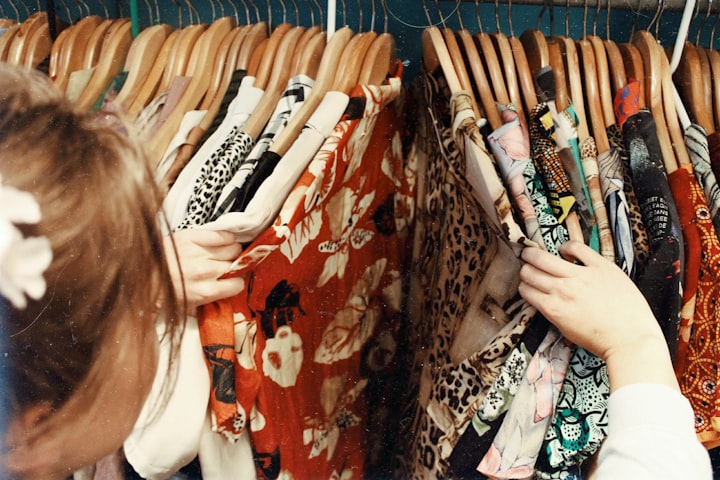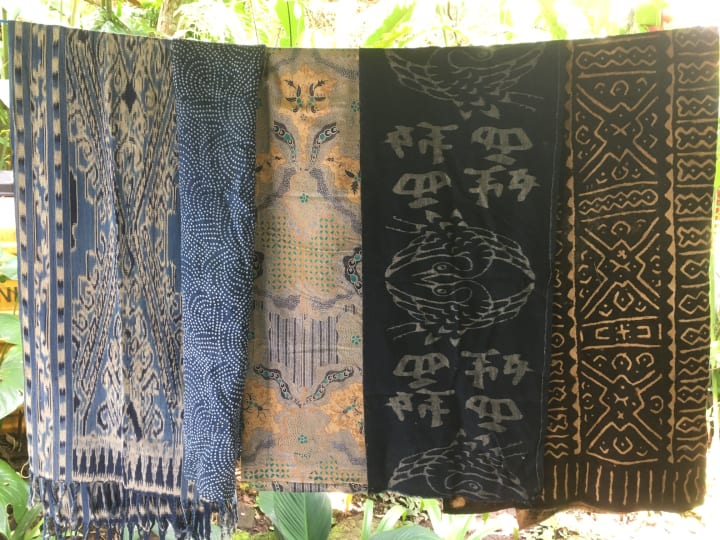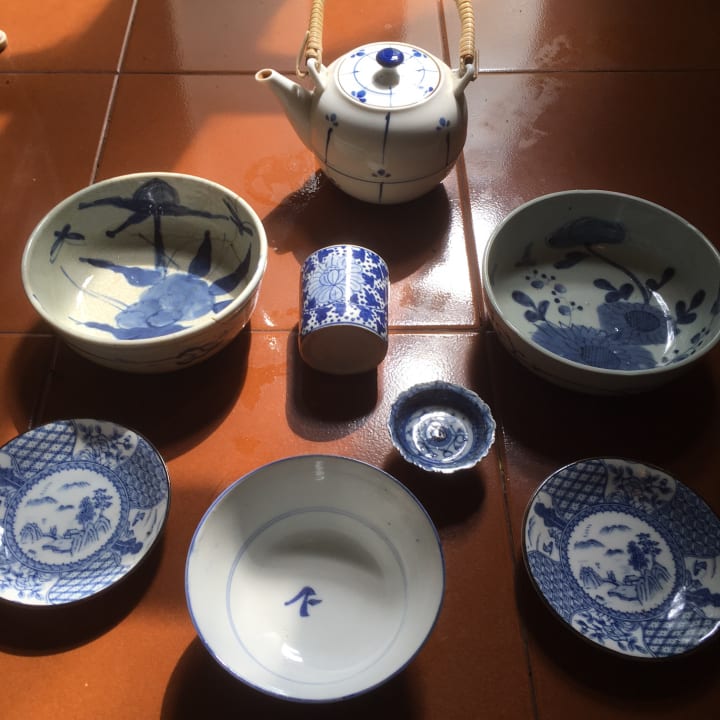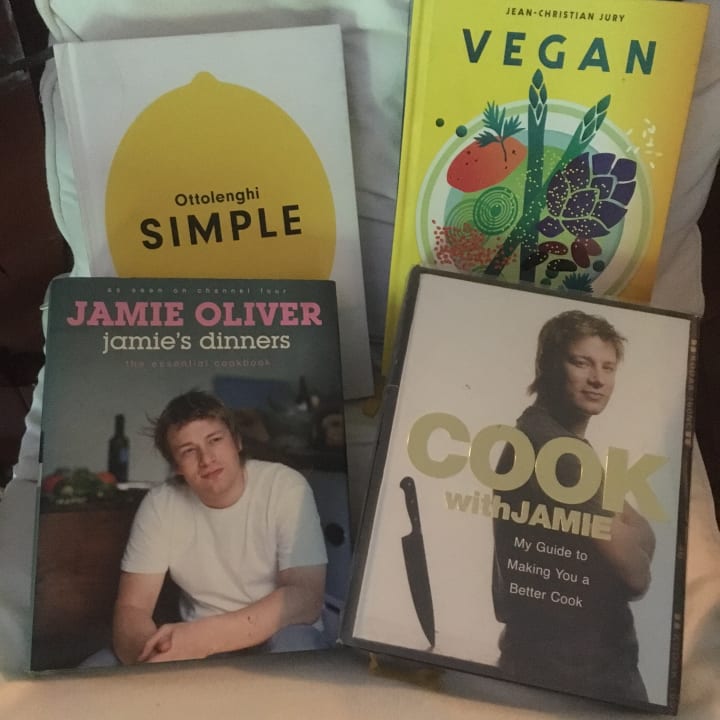Thrifting Through Life
My enduring second-hand love affair

Thrifting is in my blood. I can't walk past a garage or yard sale without stopping, and I can never resist going into a op-shop anywhere in the world. I've found favorite pieces and treasures in second-hand stores across the USA, in London and Australia, and on holiday in Italy, Singapore and Bali.
Everything I know about buying second-hand I learned from my Mom. I like to think of thrifting as her legacy to me. She was a ballet dancer in London in the 1950s and had very little money. She sewed her own clothes and then hunted through op-shops for stylish shoes and accessories. When I grew old enough, she would take me thrifting, and passed on her love, and knowledge, of the art.
Mom taught me to go frequently to a favourite op-shop, chat with the staff and be prepared to spend time trying on clothes or sorting through books and jewellery. She dressed herself impeccably from thrift stores and always looked like she wore designer labels (which she often did).

I've passed on my love of thrifting to my teen daughter and she often finds clothes she likes that she can afford on her allowance. While once she was clearly bored by having to go with me to our local thrift shop, she now goes on her own with her friends and asks me to stop there when we're out.
The virtues of thrifting
Thrifting is an adventure, a challenge, and frequently ends with a rush of excitement as you find a brand new suit with sale tags still attached, a bag of expensive, top-quality wool skeins, or a stylish pair of shoes that fit you perfectly. Thrifting is also very practical and saves you a lot of money over time. You can furnish a home, or fill your wardrobe, from op-shops for a fraction of what it would cost to buy those items new. The money you save can go towards paying bills, eating out or, in my case, travel.
Many thrift stores support a specific charity, such as The Salvation Army, Oxfam, St. Vincent de Paul and others. Your dollars are going to support vital social programs, such as employment services, drug treatment centers or homeless shelters.

Another great reason to thrift is that it's better for the environment. Buying used extends the life-cycle of clothing and household goods and moves society closer to a sustainable future.
Second-hand fashion has become very popular and no longer has the stigma about wearing "used" clothes that it once had. Companies like Thredup have "modernized" thrifting by letting consumers find exactly what they need online and order easily. In fact, the second-hand clothing market is estimated to become twice as big as fast fashion by 2029.
Setting up a thrifting system
These days, most second-hand stores only accept clothing and household items in good condition and working order so you don't have to sort through a lot of tired, stretched out, broken things. You can even find new clothing with sale tags still attached. Thrift stores usually separate clothing by age, gender and size, and sometimes even by colour, which makes the hunt much easier. Here is my list of how to become a super thrifter.

1. Choose one or two stores that have good stock that turns over regularly.
2. Visit the stores often, at least once a week.
3. Ask staff which days they put out new stock and shop on those days for the best selection.
4. Go at quiet times and days, if you can, i.e. mid-morning or mid-afternoon on weekdays when most people are at work. I don't go on weekends: it's too busy and crowded, and I have to compete for the dressing rooms.
5. Allocate at least an hour to browse. After a while you'll get faster at spotting things you like.
6. Try on everything you find (unless it's for someone else) to make sure it really fits, looks like your style, has intact buttons and zippers (and they work), and you like the feel of it. This last one is important. I once found a lovely Pringles sweater in great condition, bought it, went to wear it to work the next day and discovered it was super-itchy.
7. Don’t forget to check out the bargain bin where unsold items are often marked down to a few dollars or less.
8. Get to know the staff — they may be able to hold items or give additional discounts. Remember, if you shop there often, you're a regular customer and they want to keep you coming back.
9. Yes, you can often bargain or get further discounts.
10. Find companions — thrifting is always more fun with friends.

Here is my (pre-Covid) routine. I have two Salvation Army Family stores near my apartment. One of them is on the way home from work, so I stop in on Tuesdays and Thursdays. At 5:30 pm on a weekday, everyone else is heading home or to the gym. Tuesday is a quiet day, and there may be one or two other shoppers. Thursday is the day staff put out new stock, usually about 3-4 pm, so I'm arriving 1-2 hours after new donations have hit the racks. The manager sometimes puts something aside for me that she thinks I may like, and often gives me additional discounts. In return, I bring treats for the staff as a thank-you, always stop for a chat and shop weekly.
The second store is a short walk away and is open later, so I'll go by one evening each week. I chat with the staff and know one or two of them. They will hold items for me and I have gotten discounts there as well, but it's not my "regular regular."
Buy off-season
If you buy items in the "wrong" season, you can save even more money. In the summer, I've bought a down comforter for $15, a rolling electric oil heater for AUD $10, wool-blend blue jeans for AUD $7 and heavy leather clogs for AUD $12. In the winter, I've bought a rotating fan with a floor stand for AUD $5, an expensive silk dress for AUD $35 and sandals for AUD $5.

My favourite thrifting categories
Shoes: It's always worth having a quick look along the shoe racks. Keep in mind that worn shoes can be reheeled and scuff marks covered with dye. I've found Ecco shoes in good condition for AUD $12 a pair (retail $200), R.M. Williams boots for AUD $12 a pair (retail $300-400) and Easy Spirit, Clarks and Rockport sandals for AUD $10 a pair (retail $60-90).
Work clothes: Formal work clothes don't usually get the same level of hard wear as casual clothes. You can often find good quality skirts, suit jackets, blouses and belts in good condition. My favourite Salvation Army store has a lot of outlet stores nearby. Some of these outlets donate unsold items when they need to turn over stock. I once bought two brand new Country Road suits for work (tags still attached) for AUD $20 each (retail $400). The monthly dry-cleaning bills cost more than the suits!
Outdoor, recreational & safety equipment: I often see specialized work clothes, including hi-res safety vests, heavy duty boots and shoes, as well as hunting and fishing clothing and gear, all of which can be expensive to buy new. I've seen motorcycle helmets in good condition for AUD $30 - $50. I've seen a canoe, life-vests, hunting knives, bows, arrows and more. I once bought a Gil Hibben Bowie knife at a thrift store in California, for my brother, a veteran outdoorsman, for $34 (retail $125).
Craft supplies: I often find knitting and craft supplies for bargain prices. If you don't crochet, knit or stitch yourself, you can resell items on eBay or Etsy. I once found a bag of grey alpaca wool skeins for AUD $8, a bag with 15 balls of Jo Sharp merino wool in acid yellow for AUD $12 (retail $200) and a mixed bag of wool for AUD $5 that had enough Debbie Bliss baby cashmerino in pale blue to make a scarf. I found an Ehrman Tapestry needlepoint kit that had never been opened for AUD $6 (retail $100+) which I re-sold on eBay for $50. I also find heaps of vintage knitting needles — in wood, melamine, plastic and aluminium — for as little as $1 each.
Fabric: I often find both new and vintage fabrics. I've seen multiple yards of new fabric priced from AUD $10 - $15. If you sew, or can trade with a friend who sews, you can make yourself new clothes, or even whole outfits, very cheaply. On occasion, I have found unique vintage fabrics and hangings, including Indonesian batiks, African mud cloth and Japanese indigo. I recently saw a piece of African mud cloth listed on eBay for $82, and vintage Japanese indigo ikat panels on Etsy for $50 - $155.

Baby clothes: I often find brand-new baby outfits with the tags still attached for AUD $1. I buy them and store until needed for a baby shower or send as a gift when friends or relatives are expecting.
Housewares: You can outfit an apartment or shared house from thrift stores for a few hundred dollars. When I was a student, and moved into a small apartment, I bought everything I needed second-hand: sheets, towels, quilt, heater, fan, kitchenware, pots, pans, cookbooks. I found a Cuisinart food processer for AUD $10. I inherited a love of blue and white Chinese and Japanese porcelain from my Mom and I always look for special pieces when I go thrifting.

Furniture: The Salvation Army stores in my neighbourhood both have good stocks of furniture. You can find sofas, tables, cabinets, rugs, dining room tables and chairs, beds, desks, recliners and more, all for a fraction of what they cost new. I once bought a nearly-new futon mattress and base for AUD $50.
Jackets: Thrift stores are great for finding jackets, often in good condition. I've found ones from North Face and Patagonia. In Colorado, which is outdoor sports country, I once found a Patagonia shell with fleece in my size for under $20 and wore it daily for years. In Melbourne, I found a men's Patagonia fleece in great condition in a large size for AUD $20 and got it for my then-boyfriend who loved it, wore it constantly and may still have it.
Vintage clothes: Vintage clothes are usually better made than modern fast fashion and often unique. A few key vintage items, mixed and matched with a modern wardrobe, will give you classic, one-of-kind looks. You can also have pieces tailored inexpensively to fit you perfectly. A friend and I once walked into a second-hand shop in Garberville, California. (Yes, I thrift everywhere I go.) The owner had just received a large delivery of velvet clothes — they weren't even priced or sorted yet. My friend and I were the first customers to see them. I bought two tops, for $10 each, which have since become some of my all-time favourite pieces, and which I wear when the weather starts getting cold or when travelling. I've discovered that velvet is the perfect travel material — it keeps you warm on a chilly plane and doesn't wrinkle — and you can throw a wrap or jacket on top. Velvet also looks stylish, and you can dress it up with a black skirt or down with jeans.

Books: I've scored some expensive hardback cookbooks in second-hand shops (Ottolenghi, Jamie Oliver). The best time to shop for cookbooks is just after Christmas when people give away books they received as presents, so they're in mint condition. If you're a big reader, especially science fiction or mysteries, you can buy all your "new" reads for as little as twenty-five or fifty cents each. (In my case, cheaper than library fines.)

Making money from thrifting
When you're thrifting frequently even $5 or $10 purchases start to add up. I started finding so many great things that my shopping became an expensive habit. I decided to try re-selling on eBay. In my first year, I made close to $3000. Keep in mind, this was from stopping in two or three times a week, spending about an hour browsing and were just the things I didn't want to keep or gift. I rarely had more than 4-6 items listed for sale at a time.
I once met a woman in a Salvo store who was scanning the aisles the same way I was and we started chatting. She told me she worked full time and had a side business reselling concert T-shirts on eBay. I asked her how her side-line was going and she pointed out the window to an Audi parked in front of the store. "Used T-shirts just bought me that car," she said.
My most memorable finds
I found a pair of Doc Martens black Oxford shoes (retail $120) in a Singapore thrift store for SGD $5. I carried them home with me and wound up selling them on eBay for AUD $70.
I found a pair of Bruno Magli kid-glove black leather loafers (retail $325), nearly new, for EUR 5 in a thrift store in Florence, Italy (yes, I absolutely thrift everywhere I go). They had been mislabelled as a size 5.5. When I looked at them, I realised they were larger, more like a 7 or a 7.5. I slipped them on and discovered that they fit me like, well, a glove.
I walked into my regular Salvo store one Thursday evening to check out the new stock. The manager had a pile of suits and ties on the counter that she was pricing, so I went over for a closer look. (If you know the staff, they will let you rummage through new donations while they process them.) In the tangle of ties, I spotted a shade of orange that I recognized (from walking by a certain luxury brand storefront on Collins Street in the city every morning) and pulled out a Hermes tie, and then one from Ermenegildo Zegna (retail $180) in very good condition. I bargained the manager down to AUD $18 each (another reason to be friendly with staff) and bought them both. I gave them to the man I was dating at the time. When he wore them to work, the guys in his office demanded to know if he'd gotten a raise since he could now clearly afford $180 ties. (We're still friends years later, and I wonder if the Hermes tie had something to do with it.)
I once found six Orrefors cocktail glasses, for AUD $30, in a box that had never been opened. Because I knew the staff member who was working that day, I got the full story: the glasses had been given as a wedding gift in the 1960s, never used, stored away and finally donated to the op-shop when the owner died, still in the original box. I used them for a few years and then sold them on eBay.
I once found not one, but two, pairs of R.M. Williams boots, newly re-heeled and in good shape, for AUD $12 each (retail $300-400). Sadly, they were a size 6, and I'm a 7.5, but I bought them anyway and resold them on eBay.
My best find ever happened back in my student days in Colorado. I was flipping through a coat rack in a second-hand clothing store when I found a familiar looking, military-style brown wool coat. I pulled it out and looked at the tag. It was a Christian Dior New Look coat circa 1950, with a label from I. Magnin & Co. I'd seen photos of my Mom in the early 1950s wearing styles that looked just like this. My heart started racing. I looked at the price tag. $50. I was a student and that was a lot of money. But I knew I had to have it. With my heart in my throat, I took the coat up to the desk. I double-checked the price, certain someone must have made a mistake and that it was really $150, but the price was correct, so I bought it. I've carried that coat from Colorado to London to Melbourne.
It's nice to think that I was able to thrift a coat that my Mom might have seen in the windows of a high-end department store in 1950 but couldn't afford. I've seen a similar Dior vintage coat on eBay recently for $2000.

I hope I've inspired you to consider making thrifting a regular habit. You'll save money, help the environment, support good works, have fun, hopefully find some treasures and pass on a good legacy to the next generation.
About the Creator
Liz Sinclair
Amateur historian who loves travel and lives in Asia. I write 'what-if' historical stories, speculative fiction, travel essays and haiku.
Twitter: @LizinBali. LinkedIn: sinclairliz






Comments
There are no comments for this story
Be the first to respond and start the conversation.